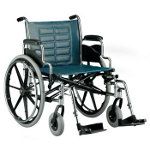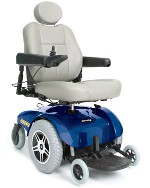The Wheelchair Guide
Your Wheelchair and Mobility Scooter Resource
What Type of Wheelchair is Best for Me?
Monday, August 9th, 2010 at 8:06 am
 A wheelchair is probably one of the most recognized types of home medical equipment and dates back much further than other types of medical equipment. However, even though the history of the wheelchair, can be traced back many thousands of years, the modern wheelchair has roots that are much much younger.
A wheelchair is probably one of the most recognized types of home medical equipment and dates back much further than other types of medical equipment. However, even though the history of the wheelchair, can be traced back many thousands of years, the modern wheelchair has roots that are much much younger.
Manual Wheelchairs
Today, most manual wheelchairs feature a folding frame that is made out of lightweight hollow metal tubes. The seat has traditionally been made out of vinyl that is sewn around the wheelchair frame, although many newer wheelchairs incorporate improved padding and support. To allow the wheelchair user to self-propel, a manual wheelchair has large real wheels with metal hand-rims attached to the outside of the wheel.
The handrims allow the user to spin the wheels freely and easily, without making contact with the part of the tire that actually touches the ground. The front wheels are much smaller and are on pivots that allow the wheelchair to be turned simply by pushing it in a certain direction or by applying more pressure to one of the handrims.
These modern manual wheelchairs vary slightly in features, with some offering things like adjustable axles or different types of front rigging, which is the place at the front of the wheelchair where the user places their foot. However, the basic design is based on the Everest and Jenning’s Wheelchair(E&J Wheelchair) that was developed during the 1930′s. At this time, most wheelchairs where made out of a combination of wood and wicker, making them extraordinarily difficult to transport and also very hard to self-propel. Two inventors, named Everest and Jenning, set out to build a wheelchair that could be easily moved from place to place and also used without the help of a caretaker, creating a wheelchair frame whose influence can still be seen today in virtually all types of manual wheelchairs.
The manual wheelchair remains the most common type of wheelchair, with many people now opting to use a sports wheelchair, which is typically smaller and offers a number of performance improvements, but electric wheelchairs are also quite popular. Electric wheelchairs are much more expensive than manual wheelchairs, but since the device is powered by an electric motor, it requires little effort on the part of the user, aside from pushing the hand control in the desired direction.
Electric Wheelchairs and Power Chairs
 Electric wheelchairs come in a number of different shapes and sizes, as well as offering a number of different control methods, but the joystick control remains the most common. The joystick is mounted to one of the armrests of the wheelchair, allowing for either left hand or right hand use, with the wheelchair users simply pushing the joystick in the direction they wish to travel. For people with limited upper-body strength, a manual wheelchair is often too difficult to use, requiring a great deal of effort, which is the reason many people opt for an electric wheelchair, or power chair.
Electric wheelchairs come in a number of different shapes and sizes, as well as offering a number of different control methods, but the joystick control remains the most common. The joystick is mounted to one of the armrests of the wheelchair, allowing for either left hand or right hand use, with the wheelchair users simply pushing the joystick in the direction they wish to travel. For people with limited upper-body strength, a manual wheelchair is often too difficult to use, requiring a great deal of effort, which is the reason many people opt for an electric wheelchair, or power chair.
For those who are unable to use the joystick control, a number of alternate wheelchair controls are also available. One of the earliest alternate controls, which was first developed around the same time as the first electric wheelchair during the 1950′s, relies on head movements to steer the wheelchair. There are also remote controls available for caretakers, as well as a variety of much more advanced systems, including those that allow the power chair to be controlled by the breath of the user.
Wheelchairs continue to be one of the most common and well known types of home medical equipment, offering a way of improving accessibility. While power chairs are very convenient and easy to use, they tend to cost a lot more than manual wheelchairs, which can typically be found both new and used for at least a thousand dollars less than a power chair.